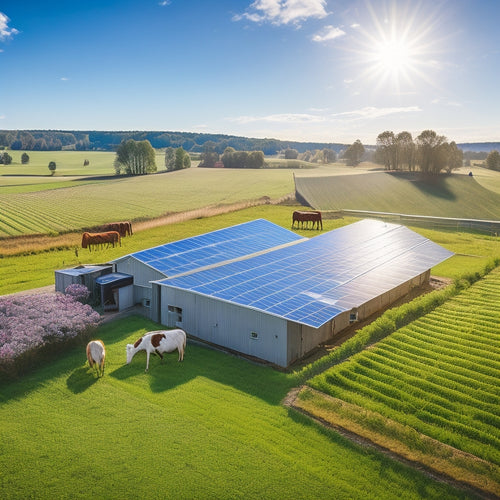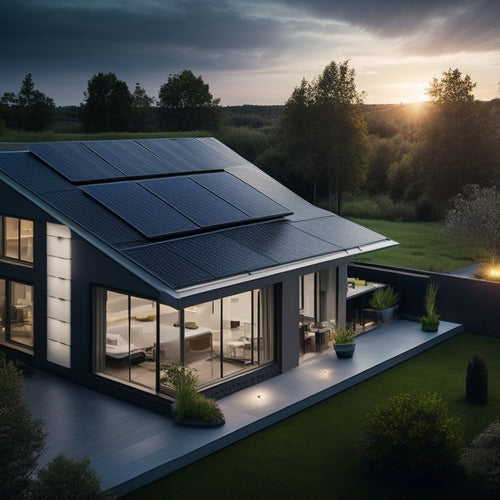
Achieve Home Energy Independence With These 5 Tips
Share
By integrating on-site energy generation, such as solar panels and wind turbines, with smart energy management systems, you can greatly reduce your reliance on the grid and take the first step towards achieving home energy independence. Prioritize inverter efficiency, selecting models with high ratings and advanced features like MPPT to enhance performance. Assess your power consumption patterns to identify areas of waste and optimize energy independence strategies. You'll save money on bills by reducing energy waste, and government incentives can help offset the cost of change. Now, uncover how to take your energy independence to the next level.
At a Glance
- Explore grid-free power sources like solar, wind, and geothermal energy to reduce reliance on the grid.
- Implement on-site energy generation through solar panels and wind turbines, and utilize battery storage systems for excess energy.
- Prioritize inverter efficiency by selecting high-efficiency inverters with advanced features like Maximum Power Point Tracking (MPPT).
- Conduct energy audits to identify areas of waste and optimize energy usage with smart home technology and energy-efficient appliances.
- Monitor daily energy usage to identify high-consumption devices and adjust usage habits to promote efficiency and reduce waste.
Reduce Reliance on Grids
You're likely aware that relying on the grid for your energy needs can be costly and unreliable.
To reduce your dependence on external power sources, you'll want to investigate grid-free power sources, such as solar, wind, and geothermal energy.
Many homeowners are turning to off-grid solar power systems to achieve energy independence.
Grid-Free Power Sources
Your energy independence journey begins with utilizing power from alternative sources, reducing your reliance on the grid.
By exploring grid-free power sources, you'll be well on your way to achieving energy independence. Solar technology and wind turbines are popular options for generating electricity.
However, energy storage is vital to guarantee a stable supply when the sun isn't shining or the wind isn't blowing. Off Grid Solar Panel Kits off-grid dwellers can provide an all-encompassing solution for those seeking to shift to off-grid solar power.
This is where battery management comes in, allowing you to store excess energy for later use. Off-grid systems and microgrid solutions can also provide reliable power.
If you have access to natural resources, consider biomass energy, hydropower options, or geothermal heating. These alternatives offer a cleaner, more sustainable way to power your home.
By diversifying your energy sources, you'll reduce your reliance on the grid and move closer to achieving energy independence.
With the right combination of technologies, you can break free from the grid and enjoy the freedom that comes with generating your own power.
On-Site Energy Generation
One essential step in reducing reliance on grids is utilizing energy on-site, an approach that allows homeowners to generate power right where they need it. By adopting on-site energy generation, you'll considerably decrease your reliance on external power sources and move closer to achieving energy independence.
Consider solar panel installation to capture the sun's energy and convert it into electricity. Additionally, with a battery storage system, you can store excess energy generated during the day to use at night or during power outages Energy Storage Solutions, gaining protection from grid outages and fluctuations that can leave you in the dark.
Alternatively, wind turbine options can provide a reliable source of power, especially in windy regions. To guarantee a stable supply of energy, invest in battery storage solutions that store excess energy generated during the day for use during periods of low energy production.
Energy management systems will help you optimize energy distribution, while microgrid technology enables you to disconnect from the grid and operate independently. By integrating these renewable energy systems, you'll be well on your way to achieving off-grid living and implementing effective energy independence strategies.
Saves Money on Bills
You can considerably reduce your energy expenses by implementing measures that lower monthly costs and cut energy waste.
By optimizing your home's energy efficiency, you'll be able to allocate more money towards other important expenses.
For instance, investing in residential solar power systems can help you generate renewable energy and save on electricity bills.
This is especially true when combined with efficient and durable house solar panels.
Lower Monthly Costs
Financial freedom is within reach when homeowners take control of their energy consumption, and it all starts with an essential step: reducing monthly costs. By adopting energy-saving habits, you can greatly lower your monthly bills.
Start by identifying areas of energy inefficiency in your home, such as outdated light bulbs or inefficient appliances. Replace them with budget-friendly upgrades like LED bulbs and Energy Star-rated appliances.
Another key strategy is to optimize your home's insulation and weatherization. Confirm that your attic, walls, and floors are well-insulated to prevent heat loss during winter and heat gain during summer. Seal any air leaks around windows and doors to prevent energy-wasting air infiltration.
By implementing these cost-effective measures, you can reduce your energy consumption and lower your monthly bills.
Additionally, consider adjusting your daily habits to conserve energy. Turn off lights, electronics, and appliances when not in use, and adjust your thermostat to use less energy for heating and cooling.
Cut Energy Waste
Frequently, homeowners overlook the simplest opportunities to cut energy waste, which can result in considerable savings on their bills. You can start by identifying areas of energy inefficiency in your home.
Begin by conducting an energy audit to pinpoint where energy is being wasted. This will help you prioritize areas for improvement.
One effective way to cut energy waste is to upgrade to energy-efficient appliances. Look for appliances with the ENERGY STAR label, which indicates they meet energy efficiency standards set by the U.S. Environmental Protection Agency.
For instance, replacing traditional incandescent light bulbs with LED bulbs can considerably reduce energy consumption.
You can also utilize smart home technology to optimize your energy usage. Smart thermostats, for example, can learn your schedule and preferences to adjust the temperature accordingly, reducing energy waste.
Additionally, smart plugs can help you identify which devices are consuming the most energy, allowing you to make informed decisions about energy usage.
Inverter Efficiency Matters Most
You'll want to prioritize inverter efficiency to maximize your energy independence.
This means focusing on peak power output, which directly impacts the amount of energy your system can generate.
When selecting an inverter, consider off-grid solar systems that optimize energy production and reduce waste.
Peak Power Output
At the heart of your home energy independence system lies the inverter, responsible for converting DC power from your solar panels or energy storage system into usable AC power for your home.
To achieve peak power output, it's essential to select an inverter that can handle the maximum power output of your system. This is where inverter efficiency matters most. Look for an inverter with a high peak efficiency rating, typically above 95%, to guarantee you're getting the most out of your system. A high-efficiency inverter translates to more power available for your home, reducing your reliance on the grid and increasing your energy independence.
To optimize peak performance, consider an inverter with advanced features such as maximum power point tracking (MPPT) and dual-stage monitoring. MPPT technology allows the inverter to track the maximum power output of your solar panels, while dual-stage monitoring enables real-time monitoring of your system's performance.
Energy Loss Reduction
Your inverter's efficiency plays a critical role in reducing energy loss, as even slight inefficiencies can translate to significant losses over time. To minimize energy loss, focus on optimizing your inverter's performance. Look for inverters with high efficiency ratings, typically above 95%. Additionally, guarantee proper installation, maintenance, and monitoring to prevent technical issues that can lead to energy loss.
| Energy Loss Reduction Strategies | Benefits |
|---|---|
| Installing thermal insulation in your home | Reduces heat loss and energy consumption |
| Conducting regular energy audits | Identifies areas of energy inefficiency and provides actionable observations |
| Optimizing inverter performance | Minimizes energy loss due to inverter inefficiencies |
| Implementing energy-efficient appliances | Reduces overall energy consumption |
Assess Power Consumption Patterns
You'll need to pinpoint the devices and appliances that consume the most energy in your home, known as "energy hogs," to optimize your energy independence strategy.
To do this, you'll want to track your daily energy usage patterns to identify when and where energy is being wasted. By monitoring your energy consumption, you'll be able to create a more accurate and effective plan for reducing your reliance on the grid.
With the help of renewable energy systems, you can identify areas where energy storage solutions can be implemented to reduce your energy bills.
Additionally, understanding your power consumption patterns will also enable you to select the right solar power systems and battery storage solutions for your home.
Identify Energy Hogs
Identifying energy hogs in your home is essential to achieving energy independence. You can't manage what you don't measure, so start by monitoring your energy consumption patterns. This will help you pinpoint which appliances and devices are guzzling the most power.
Consider upgrading to energy-efficient models with high efficiency ratings, especially for devices with long lifespans. Smart technology can also help you stay on top of consumption awareness, enabling you to make behavioral changes that reduce waste.
Conduct an energy audit to identify areas for improvement, and prioritize power management strategies to optimize your energy usage. By doing so, you'll be able to identify energy hogs and take targeted action to eliminate them.
This might involve adjusting your usage habits, such as turning off lights and electronics when not in use, or replacing old devices with energy-efficient alternatives. By taking control of your energy consumption, you'll be well on your way to achieving energy independence.
Track Daily Usage
Having pinpointed the energy hogs in your home, it's now time to examine your daily usage patterns to better comprehend how they're impacting your overall energy consumption.
By tracking your daily usage, you'll gain significant observations into your energy monitoring habits and identify areas for improvement.
Invest in a smart plug or an energy monitoring system that provides real-time data on your energy usage trends. This will help you pinpoint the times of day when your energy consumption is highest and lowest.
You'll be able to see how your daily habits, such as turning on lights or appliances, affect your energy usage.
Analyze your usage trends to identify patterns and anomalies.
Are you using more energy during the morning or evening? Are there specific days of the week when your energy consumption is higher?
Government Incentives Boost Adoption
You'll be pleased to know that government incentives can greatly offset the cost of shifting to renewable energy sources.
One of the most notable incentives is the Renewable Energy Credit (REC) program, which allows you to earn credits for every megawatt-hour of electricity generated from renewable sources.
Renewable Energy Credits
How can you benefit from the government's push to promote renewable energy? One way is through Renewable Energy Credits (RECs), a market-based system that incentivizes clean energy production.
When you invest in renewable energy, such as solar or wind power, you earn RECs, which can be traded on the open market. This credit trading system allows you to offset the cost of your investment by selling your excess credits to companies or individuals who need them to meet their renewable energy targets.
As you generate more renewable energy, you accumulate more RECs, increasing your potential earnings. You can sell these credits to utilities, companies, or even other homeowners, providing a new revenue stream.
This system not only helps you achieve home energy independence but also supports the growth of the renewable energy industry as a whole. By participating in credit trading, you're contributing to a cleaner, more sustainable energy future while enjoying the financial benefits of your investment.
Frequently Asked Questions
Can I Install a Solar Panel System Myself?
You can attempt a DIY solar panel installation, but be aware that it's a complex process requiring electrical and roofing proficiency, so it's recommended to hire a professional to guarantee a safe and efficient solar panel system.
How Long Does a Typical Home Battery Last?
You're wondering how long your home battery will last, right? Typically, a home battery's lifespan ranges from 10 to 15 years, depending on usage and quality, providing reliable energy storage and backup power when you need it most.
Are Energy-Independent Homes More Valuable?
You'll be pleased to know that achieving energy independence greatly enhances your property's value, as it provides a unique selling point, increasing your home's appeal and resale price, thanks to the numerous energy independence benefits that attract eco-conscious buyers.
Can I Use a Generator as Backup Power?
You're worried about relying on generators, but don't be - you can choose from various types, like portable or standby generators, and select one that matches your power capacity needs, ensuring a seamless backup power experience.
Do Energy-Independent Homes Require More Maintenance?
You'll find that energy-independent homes don't necessarily require more maintenance, but you'll need to perform routine checks and DIY repairs to guarantee peak performance, which can actually increase your sense of freedom and self-sufficiency.
Explore More
You've taken the first step towards cutting the cord from the grid and utilizing the power of independence. Now, it's time to flip the switch and watch your energy bills shrink like a deflated balloon. By following these 5 tips, you'll be well on your way to achieving home energy independence, and reaping the benefits of a reduced carbon footprint and lower utility bills.
Related Posts
-

What Do I Need to Know About Farm Solar Panels
When considering farm solar panels, you need to assess costs, benefits, and technical specifics. Initial investment c...
-

Smart Home Thermostats to Revolutionize Your Space
Smart home thermostats revolutionize your space by providing precise temperature control and optimizing energy saving...
-

Home Solar Battery
You're opting for a home solar battery that allows you to utilize the power of the sun during the day and use it at n...


